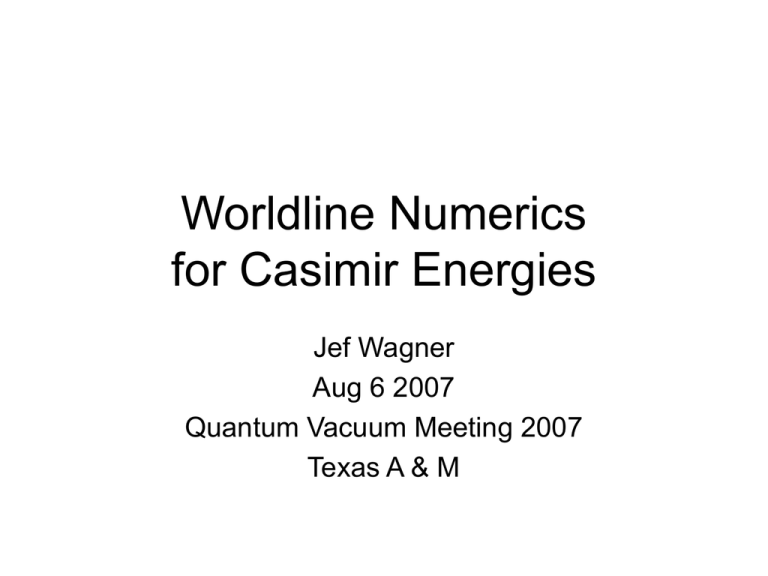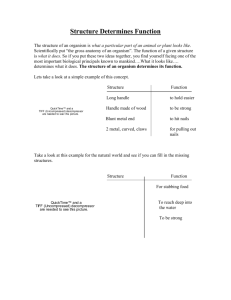Worldline Numerics for Casimir Energies Jef Wagner Aug 6 2007
advertisement

Worldline Numerics for Casimir Energies Jef Wagner Aug 6 2007 Quantum Vacuum Meeting 2007 Texas A & M Casimir Energy • Assume we have a massless scalar field with the following Lagrangian density. • The Casimir Energy is given by the following formula. Casimir Energy • We write the trace log of G in the worldline representation. • The Casimir energy is then given by. Interpretation or the Path Integrals • We can interpret the path integral as the expectation value, and take the average value over a finite number of closed paths, or loops, x(u). Interpretation of the Path integrals • To make the calculation easier we can scale the loop so they all have unit length. • Now expectation value can be evaluated by generating unit loops that have Gaussian velocity distribution. Expectation value for the Energy • We can now pull the sum past the integrals. Now we have something like the average value of the energy of each loop y(u). • Let I be the integral of potential V. Regularizing the energy • To regularize the energy we subtract of the self energy terms • A loop y(u) only contributes if it touches both loops, which gives a lower bound for T. Dirichlet Potentials • If the potentials are delta function potentials, and we take the Dirichlet limit, the expression for the energy simplifies greatly. Ideal evaluation • Generate y(u) as a piecewise linear function • Evaluate I or the exponential of I as an explicit function of T and x0. • Integrate over x0 and T analytically to get Casimir Energy. X0 changes the location of the loop T changes the size of the loop A loop only contributes if it touches both potentials. A loop only contributes if it touches both potentials. A loop only contributes if it touches both potentials. Parallel Plates • Let the potentials be a delta function in the 1 coordinate a distance a apart. • The integrals in the exponentials can be evaluated to give. Parallel Plates • We need to evaluate the following: • The integral of this over x0 and T gives a final energy as follows. Error • There are two sources of error: – Representing the ratio of path integrals as a sum. Error • There are two sources of error: – Discretizing the loop y(u) into a piecewise linear function. Worldlines as a test for the Validity of the PFA. • Sphere and a plane. QuickTime™ and a TIFF (U ncompressed) decompressor are needed to see this picture. Worldlines as a test for the Validity of the PFA. • Cylinder and a plane. QuickTi me™ and a TIFF (U ncompressed) decompressor are needed to see this pi cture. Casimir Density and Edge Effects • Two semi-infinite plates. QuickTi me™ and a TIFF (U ncompressed) decompressor are needed to see thi s picture. QuickTime™ and a TIFF (Uncompressed) decompressor are needed to see this picture. Gies KlingMuller Phys.Rev.Lett. 97 (2006) 220405 Casimir Density and Edge Effects • Semi-infinite plate over infinite plate. QuickTime™ and a TIFF (U ncompressed) decompressor are needed to see this picture. QuickTi me™ and a TIFF (U ncompressed) decompressor are needed to see this pi cture. Gies KlingMuller Phys.Rev.Lett. 97 (2006) 220405 Casimir Density and Edge Effects • Semi-infinite plate on edge. QuickTime™ and a TIFF (U ncompressed) decompressor are needed to see this picture. QuickTi me™ and a TIFF (U ncompressed) decompressor are needed to see this picture. Gies KlingMuller Phys.Rev.Lett. 97 (2006) 220405 Works Cited • Holger Gies, Klaus Klingmuller. Phys.Rev.Lett. 97 (2006) 220405 arXiv:quant-ph/0606235v1 • Holger Gies, Klaus Klingmuller. Phys.Rev.Lett. 96 (2006) 220401 arXiv:quant-ph/0601094v1



